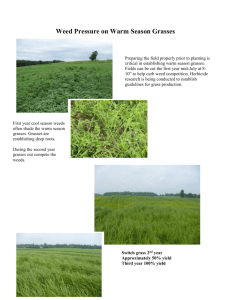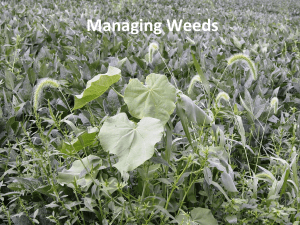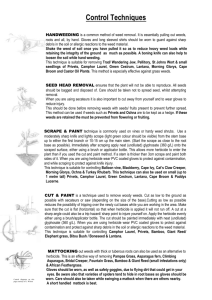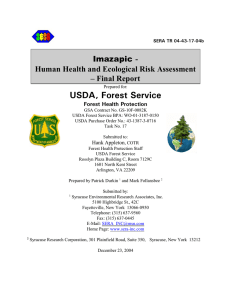Hamilton County Urban Conservation Association weed control and
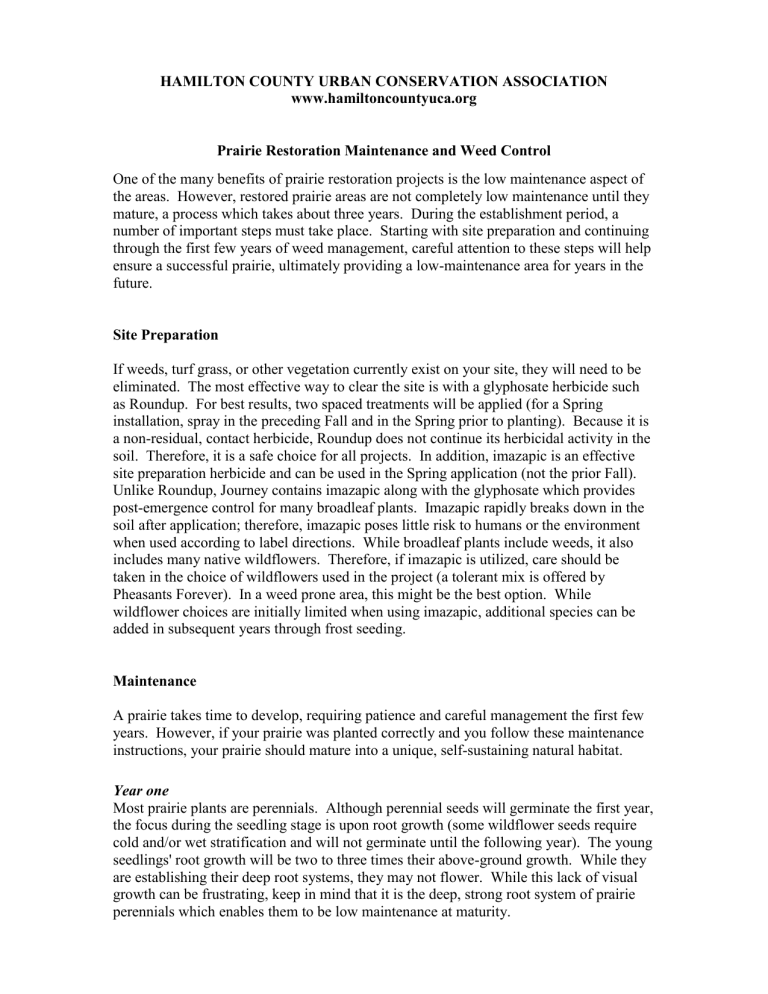
HAMILTON COUNTY URBAN CONSERVATION ASSOCIATION www.hamiltoncountyuca.org
Prairie Restoration Maintenance and Weed Control
One of the many benefits of prairie restoration projects is the low maintenance aspect of the areas. However, restored prairie areas are not completely low maintenance until they mature, a process which takes about three years. During the establishment period, a number of important steps must take place. Starting with site preparation and continuing through the first few years of weed management, careful attention to these steps will help ensure a successful prairie, ultimately providing a low-maintenance area for years in the future.
Site Preparation
If weeds, turf grass, or other vegetation currently exist on your site, they will need to be eliminated. The most effective way to clear the site is with a glyphosate herbicide such as Roundup. For best results, two spaced treatments will be applied (for a Spring installation, spray in the preceding Fall and in the Spring prior to planting). Because it is a non-residual, contact herbicide, Roundup does not continue its herbicidal activity in the soil. Therefore, it is a safe choice for all projects. In addition, imazapic is an effective site preparation herbicide and can be used in the Spring application (not the prior Fall).
Unlike Roundup, Journey contains imazapic along with the glyphosate which provides post-emergence control for many broadleaf plants. Imazapic rapidly breaks down in the soil after application; therefore, imazapic poses little risk to humans or the environment when used according to label directions. While broadleaf plants include weeds, it also includes many native wildflowers. Therefore, if imazapic is utilized, care should be taken in the choice of wildflowers used in the project (a tolerant mix is offered by
Pheasants Forever). In a weed prone area, this might be the best option. While wildflower choices are initially limited when using imazapic, additional species can be added in subsequent years through frost seeding.
Maintenance
A prairie takes time to develop, requiring patience and careful management the first few years. However, if your prairie was planted correctly and you follow these maintenance instructions, your prairie should mature into a unique, self-sustaining natural habitat.
Year one
Most prairie plants are perennials. Although perennial seeds will germinate the first year, the focus during the seedling stage is upon root growth (some wildflower seeds require cold and/or wet stratification and will not germinate until the following year). The young seedlings' root growth will be two to three times their above-ground growth. While they are establishing their deep root systems, they may not flower. While this lack of visual growth can be frustrating, keep in mind that it is the deep, strong root system of prairie perennials which enables them to be low maintenance at maturity.
During this early stage of establishment, weeds will take advantage of the lack of aboveground vegetation and appear on your site. To minimize the adverse effects of tall weeds shading prairie seedlings and to prevent these weeds from setting seed, a weed management plan should be established. Weed management can be accomplished through herbicide treatments, mowing, or a combination of the two.
Panoramic herbicide, formerly Plateau, contains imazapic which can be used to control many broadleaf weeds and undesirable cool season grasses. Panoramic does not contain glyphosate like Journey; therefore, it can be applied post emergence. However, newly emerged grasses may be sensitive to Panoramic and/or the adjuvant used. Therefore, you should wait until the grasses reach the five leaf stage before using imazapic and use a nonionic or silicone surfactant. Do not use methylated seed oil as some grasses lose their imazapic tolerance with its use. Furthermore, if Journey was utilized in the Spring preemergent herbicide application, care should be taken as to not exceed the maximum annual tolerance rate for the plant species in the prairie. In addition to providing weed control, imazapic will contribute to prairie grasses heading out and producing seed the establishment year. However, an imazapic tolerant wildflower mix must be used on the site (mix available through Pheasants Forever).
If mowing will be your weed management plan, you should plan to cut your planting up to three times during its first growing season (generally when weeds reach 10 to 15 inches in height, but always before they set seed). This is generally done by mowing on
30-day intervals during the summer. Summer mowing places stress on the weeds during the hot, dry periods and can improve weed control. Mowing is effective, but it is important to keep the blade set as high as possible. A height of six to eight inches is generally used on the first mow and raised as needed in order to cut above the native plant growth. While the mowing will control weed seed development, it can also reduce blooming of desired plants especially if a non-aggressive annual is added to the planting.
Hand weeding is also useful during the first growing season, especially to remove individual noxious weeds such as thistle. These aggressive weeds may have to be treated with spot herbicide spraying (either RoundUp or 2-4-D). This can be accomplished by the landowner using a backpack sprayer or outsourcing the service. At no time should fertilizers be used. Prairie plants are well-adapted to their environment and do not need fertilization. This expensive practice is not only unnecessary in a natural habitat, but is detrimental because it can encourage weeds and other undesirable vegetation.
If cool season grasses and/or winter annual weeds continue to persist at the end of the first year, a fall RoundUp treatment can be used. However, RoundUp cannot be used prior to the desired species reaching dormancy. Spraying RoundUp prior to the desired plants going dormant will also result in these plants being killed. Once the warm season grasses and desirable broadleaf plants have gone into dormancy, they will not absorb the glyphosate and RoundUp is safe to use. This generally occurs after the first hard frost.
Year two
During the second season, residual seeds from the first season will germinate and some of the faster growing native plants will flower and produce seed. However, there may still be a need for weed control. The height and density of the weed cover should help determine if and when to treat or mow.
Similar to the fall RoundUp treatment, RoundUp and Journey herbicides can be used in the early Spring prior to the warm season grasses and desirable broadleaf plants breaking dormancy. However, once these plants break dormancy and have started to green,
RoundUp and Journey can no longer be used.
Another imazapic/Panoramic application could be used if needed during the second year.
If Journey was used in an early Spring application, the imazapic application should not exceed the recommended annual application rate for the species included in the prairie.
In addition, one mowing might be necessary sometime between mid-June and mid-
August if mowing is your weed management plan. In areas where weeds are especially dominant, the advantages of cutting the weeds and preventing them from setting seed offset any disadvantages of cutting prairie plants. If mowed, the height will generally be
12 inches or more. Mowing and the continued development of prairie species should eliminate the weeds in time.
Spot spraying individual noxious weeds might still be necessary.
Year three
By the third year (and in the years to follow) your patience will begin to pay off. Both native grasses and wildflowers will be mature, providing a beautiful, low-maintenance habitat. While not required, one cutting per year can be used as a clean-up procedure if the area looks too ragged for the landowner. The best time to cut off old prairie vegetation is in early Spring or late Fall.
Once Established
Once a planting becomes established and undesirable plants are eliminated or under control, some type of periodic disturbance will maintain the health and vigor of the prairie species and will help keep invading woody species in check. This disturbance can involve discing, mowing or burning all or part of the planting. Prairie species evolved with fire and grazing; therefore, they benefit from this activity.
In nature, fire has been the primary disturbance method. Therefore, a controlled burn is a useful maintenance tool, but requires expertise. In addition, fire may not be an option in the urban setting. Be certain to check local regulations and permit procedures prior to this procedure and always use caution.
Alternate Planting Option (warm season grass only)
In areas where weed control is a concern, a viable planting alternative consists of focusing upon the establishment of the native warm season grasses. Under this option, the site preparation procedures would be the same as above. However, the seed mix would be solely comprised of native grasses. Wildflowers would initially be excluded from the planting. This option would allow the widespread application of broadleaf herbicides such as 2-4-D during the establishment period. Most broadleaf herbicides target broadleaf plants such as weeds, but generally do not impact grasses. However, careful attention should be paid to the herbicide chosen as some broadleaf herbicides still cannot be used on grasses in the seedling stages. In addition, imazapic can be used to control cool season grasses. Imazapic application should be consistent with the prior directions. Imazapic and 2-4-D should not be used at the same time as the combined use can actually reduce the effectiveness
This alternative planting allows for an effective weed control method that can even be outsourced. The drawback with this option is that wildflowers are also broadleaf plants and would be eliminated by the herbicide. The advantage of weed control would need to be weighed against the lack of wildflowers when deciding to implement this option. If this option is chosen, wildflowers can be added once the grasses are established and the broadleaf herbicide application ceases. In addition, wildflowers could be included to the planting in highly visible areas such as the front strip of the site. This would provide flowers for the visible appeal, but also allow herbicide weed control for the bulk of the planting. However, care must be taken in the broadleaf herbicide application as the wildflower areas cannot be sprayed (including spray drifting). Once the grasses are established, the broadleaf herbicide application would be stopped and wildflowers could be added to the grass area.
Plan Time Line
Prior Fall : Complete vegetation eradication.
Fall prior to planting (September): RoundUp application
Year one : Continue site prep, plant, and mow or apply herbicide for weed control.
Spring prior to planting (April): RoundUp or Journey application
Planting (May-June): Plant seed mix (NWSG/wildflower mix, NWSG/imazapic tolerant wildflower mix if Panoramic is to be used as the broadleaf herbicide, or
NWSG mix if using broadleaf herbicide for weed control)
Summer (June-August): Apply herbicide (Panoramic if included tolerant mix or 2-4-
D if pure grass stand) or mow if necessary depending upon which mix option was chosen and the height of the grass at the time of the needed weed control. Refer to herbicide label to determine grass height requirement for safe application as some herbicides require grasses to exceed the 4 or 5 leaf stage before use. If mowing, keep the cut height above NWSG starting at 8-10 inches and raising to 15+ inches
Fall (November): If desired/needed, apply RoundUp to control cool season grasses and winter annual weeds after desired plants go into dormancy.
Fall: Mow if desired for cleanup or appearance.
Year two : Mow or herbicide application (depending upon planting mix) for weed control as needed.
Early Spring (March-Early April): If desired/needed, apply RoundUp or Journey to control cool season grasses and winter annual weeds prior to desired plants breaking dormancy.
Summer: (May-August): Apply herbicide (Panoramic for imazapic tolerant plantings or 2-4-D for grass plantings) or mow for weed control as needed.
Fall (November): If desired/needed, apply RoundUp to control cool season grasses and winter annual weeds after desired plants go into dormancy.
Fall: Mow if desired for cleanup or appearance.
Year three : Year two steps can be utilized as needed.
© Hamilton County Urban Conservation Association, Inc. www.hamiltoncountyuca.org
